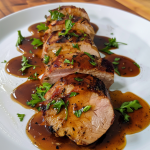Introduction to Roasted Pork Loin
Roasted pork loin is a culinary favorite thanks to its tender texture, mild flavor, and versatility. Its uniform shape and lean composition make it ideal for even roasting, resulting in juicy slices with a golden crust. Unlike pork shoulder, which is fattier and suited for slow cooking, or tenderloin, which is smaller and more delicate, pork loin offers the perfect balance of size and structure for roasting.
This cut is a go-to for both festive gatherings and casual weeknight meals. It pairs beautifully with herbs, fruits, and vegetables, adapting to seasonal flavors. Its ability to feed a crowd economically and elegantly makes it a holiday staple, while its quick prep and reliable results make it a weeknight winner. Whether served with pan gravy or roasted apples, pork loin delivers comfort and sophistication in every bite.
Choosing the Right Cut
When selecting pork loin, choose between boneless and bone-in. Boneless loins are easier to slice and cook faster, while bone-in versions offer richer flavor and a more dramatic presentation. Look for meat that’s pale pink with firm texture and minimal liquid in the packaging. Avoid cuts with grayish tones or excessive fat.
For planning, estimate about ½ pound (225g) of pork loin per person. This ensures generous portions without waste. If serving with hearty sides or appetizers, you can reduce slightly. Always check the label for freshness and sourcing—local or organic options often yield better flavor and texture.
Ingredients Overview
Classic roasted pork loin calls for garlic, rosemary, olive oil, white wine, salt, and pepper—ingredients that enhance its natural flavor. Garlic and rosemary create a fragrant crust, while olive oil helps the meat brown beautifully. White wine adds acidity and depth to pan juices.
Optional additions include fennel or dill seeds for a subtle anise note, lemon zest for brightness, and shallots for sweetness. Roasted carrots, apples, pears, or even parsnips complement the pork’s savory profile. Top recipes often vary by herb blend or fruit pairing, allowing you to tailor the dish to seasonal ingredients or personal taste.
Prepping the Pork Loin
Start by trimming excess fat, leaving a thin layer to baste the meat during roasting. Slashing the surface in a crosshatch pattern allows seasoning to penetrate deeper. Generously season with salt and pepper, then rub with a garlic-herb paste made from minced garlic, chopped rosemary, olive oil, and lemon zest.
Massage the paste into the slashes and all over the surface. For added flavor, tuck slivers of garlic into the cuts. If using vegetables or fruit, arrange them around the loin in the roasting pan. Let the meat sit at room temperature for 30 minutes before roasting—this ensures even cooking and better texture. Prepping ahead allows flavors to meld and reduces kitchen stress during mealtime.
Marinade & Flavor Boosters
For deeper flavor, marinate the pork loin overnight in a mixture of olive oil, garlic, herbs, and citrus zest. This tenderizes the meat and infuses it with aromatic notes. If short on time, a quick rub with the same ingredients works well.
Enhance the dish with white wine, apple cider, or chicken stock in the roasting pan. These liquids create steam and flavorful drippings. Pairing the pork with apples, carrots, or shallots adds sweetness and texture. These elements caramelize beautifully during roasting, complementing the savory meat and creating a built-in side dish.
Roasting Techniques
The standard roasting method involves cooking the pork loin at 350°F (175°C) for about 1 hour, or until the internal temperature reaches 145°F (63°C) for medium. This yields a tender, slightly pink center. For crispier edges, sear the loin in a hot pan before roasting.
Alternatively, the slow roast method cooks the pork at 160°C (320°F) for 8 hours, ideal for bone-in cuts or larger loins. This technique produces incredibly juicy meat with a melt-in-your-mouth texture. It’s perfect for holiday feasts or when you want to prep ahead and let the oven do the work.
Always use a meat thermometer to check doneness. Insert it into the thickest part of the loin, avoiding bone. Once it hits 145°F, remove from the oven and tent with foil. The temperature will rise slightly as it rests. Avoid overcooking, which can dry out the meat. Roasting with vegetables or fruit adds flavor and visual appeal, making the dish a complete meal.
Pan Sauce & Gravy
After roasting, use the pan drippings to create a flavorful sauce. Deglaze the pan with white wine, scraping up browned bits. Add a tablespoon of flour and whisk until smooth, then pour in chicken stock or reserved marinade. Simmer until thickened.
For a richer gravy, include a splash of cream or a knob of butter. Serve the sauce in a gravy boat or drizzle directly over sliced pork. Garnish with fresh herbs for a polished finish. This pan sauce ties the dish together, enhancing both the meat and any accompanying vegetables or fruit.
Resting & Slicing
Resting the pork loin for 10–15 minutes after roasting is essential. It allows juices to redistribute, resulting in moist, flavorful slices. Tent the meat loosely with foil to retain warmth without steaming.
When slicing, use a sharp carving knife and cut across the grain into ½-inch thick slices. For bone-in loins, slice between the bones for even portions. Arrange slices on a platter with roasted vegetables or greens like sautéed kale or Brussels sprouts. This not only enhances presentation but balances the richness of the pork with fresh, earthy sides.

Roasted Pork Loin – Juicy, Herb-Crusted & Perfect for Any Occasion
Equipment
- Roasting pan
- Meat thermometer
- Sharp knife
- Small bowl
- Skillet (for pan sauce)
- Foil (for resting)
Ingredients
Pork & Seasoning
- 3–4 lb boneless pork loin
- 4 cloves garlic, minced
- 2 tbsp fresh rosemary, chopped
- 1 tbsp olive oil
- 1 tsp lemon zest
- 1 tsp salt
- ½ tsp black pepper
Optional Additions
- 1 tsp fennel seeds or dill seeds
- 2 shallots, halved
- 2 carrots, chopped
- 1 apple or pear, sliced
Pan Sauce
- ½ cup white wine
- 1 tbsp flour
- 1 cup chicken stock
- 1 tbsp butter (optional)
Instructions
Prep the Pork:
- Trim excess fat, leaving a thin layer. Slash the surface in a crosshatch pattern.
Make Garlic-Herb Paste:
- Mix garlic, rosemary, olive oil, lemon zest, salt, and pepper in a bowl. Rub generously over pork, pressing into slashes.
Optional Marination:
- For deeper flavor, marinate overnight in the fridge. Bring to room temperature 30 minutes before roasting.
Roast:
- Preheat oven to 350°F (175°C). Place pork in a roasting pan with optional vegetables and fruit. Roast for 1 hour or until internal temp reaches 145°F (63°C).
- Rest:
- Remove from oven and tent with foil. Let rest for 15 minutes.
Make Pan Sauce:
- Deglaze pan with white wine, scraping browned bits. Add flour and whisk. Pour in stock and simmer until thickened. Finish with butter if desired.
Slice & Serve:
- Slice pork across the grain. Serve with pan sauce and sides like mashed potatoes or kale.
Notes
- Bone-in pork loin adds flavor but may require longer cooking.
- For a fruit-glazed variation, brush with apple cider or pear sauce during the last 20 minutes.
- Slow roast method: 160°C (320°F) for 8 hours for ultra-tender results.
- Use fennel and dill seeds for a unique aromatic twist.
- Store leftovers in fridge (4 days) or freezer (3 months). Reheat gently in oven or skillet with broth.





